|
Messerschmitt
Bf 110 C-2/C-4
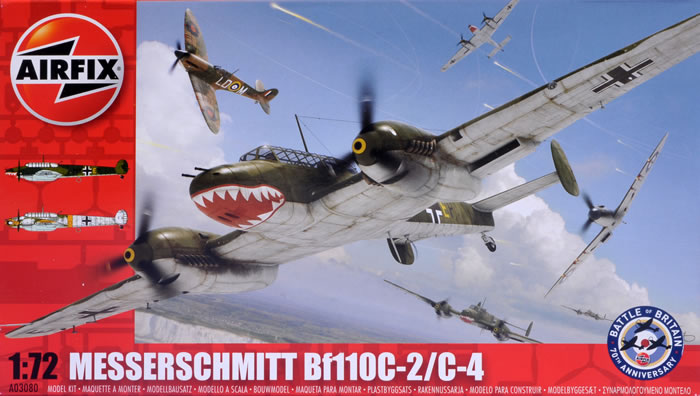
Airfix 1/72 scale
S
u m m a r y |
| Description and Catalogue Number: |
Airfix A03080 - Messerschmitt Bf 110 C-2/C-4 |
| Scale: |
1/72 |
| Contents and Media: |
99 parts in grey injection moulded plastic; two parts in clear plastic; markings for two aircraft |
| Price: |
From £6.80 available online from Hannants |
| Review Type: |
FirstLook |
| Advantages: |
Well detailed; accurate outline; large number of useful options; straightforward construction; clever engineering for parts such as exhaust stacks; parts breakdown suggests that we will see more variants; comprehensive decals. |
| Disadvantages: |
Panel lines will be too deep and wide for some tastes; thick, one-piece canopy. |
| Conclusion: |
Modellers have waited a very long time for a decent quality 1/72 scale Messerschmitt Bf 110 as a mainstream injection moulded kit. The new Airfix Bf 110 C-2/C-4 fills this important gap. The budget price and straightforward parts breakdown will be ideal to newer modellers too. |
Reviewed by Brett Green
The Messerschmitt Bf 110 entered the Second World War as a new and prestigious weapon of the Luftwaffe, performing the roles of bomber escort, heavy fighter and troop support during the German invasion of Poland. It performed well against Polish fighters, and put its heavy armament to effective use against ground targets after the Luftwaffe had established air superiority. The Bf 110 repeated these roles during the campaign in the West. The long range of the Bf 110 was especially useful for escorting bombers deep into France.
The twin engine Messerschmitt was more than a match for most contemporary French fighters, but early encounters with Spitfires and Hurricanes resulted in unaccustomedly heavy losses. This was an ominous indicator of the coming months over the British Isles.
In those Summer months of 1940, Messerschmitt Bf 110s on long-range escort missions suffered heavy losses to British fighters.
Even if its fortunes as a pure fighter aircraft were mixed, the Messerschmitt Bf 110 had a better record as a defensive weapon.
As early as December 1939, Bf 110 C aircraft of I./ZG 76 were involved in the decimation of an armed reconnaissance patrol over the Heligoland Bight. Eight Wellingtons out of a total 22 on patrol were claimed by the Zerstörers. This single event put massed daylight bombing off the agenda until 1943, but ZG 2 and ZG 76 continued to enjoy superiority over Blenheims and Wellingtons in the following months.
Arguably the most important contribution made to the German war effort by the Messerschmitt Bf 110 was as a night fighter. The role was initially ad-hoc. From July, 1940, day fighters were simply painted black and sent aloft to deal with British bombers, now making their attacks under the relative protection of darkness. These early night fighters had no additional equipment nor ground control assistance. Enemy aircraft were held in the cone of a searchlight, and the Bf 110 would engage the bomber while it was illuminated in the beam.
The Messerschmitt Bf 110 C soldiered on as a fighter-bomber into the mid-war years on the Eastern Front and North Africa.
1/72 scale Messerschmitt Bf 110s
Modellers have been blessed with a recent run of excellent new Messerschmitt Bf 110 kits in both 1/48 and 1/32 scales from Eduard and Dragon.
1/72 scale modellers have not fared so well. Easily the best Bf 110 kit in 1/72 scale is the short-run High Planes kit, but this model is in limited supply and best suited to experienced modellers.
Italeri's 1/72 scale Bf 110s were disappointing from an accuracy viewpoint and the Fujimi kit is skinny in the fuselage and undertailed. The only other mainstream Bf 110 kits - from Matchbox, Airfix and Monogram - all date from the 1960s. In fact, the currently available 1/72 scale Revell Bf 110 E is in fact a rebox of the 1967-vintage Monogram kit, sans stand.
Enter Airfix with their new 1/72 scale Messerschmitt Bf 110 C-2/C-4 kit.
The new Airfix Bf 110 C comprises 99 parts in light grey plastic, two parts in clear and markings for two aircraft.
Moulding quality is very good indeed. The parts have a satin finish, and the only imperfections I could find were one sinkmark on the side of the long boat tail extension and a few ejector pin marks on the inside of the main wheel covers.
Surface detail is by way of recessed panel lines. In common with other recent Airfix releases, the lines are relatively wide and deep. By contrast, fabric texture on the control surfaces is very subtle indeed.
Detail is good. The wheel wells and undercarriage are particularly well done. The wheel wells are boxed in and feature correct frame detail on the sides and recessed space for the retracted wheel on the well's ceiling. The main wheels are bulged and flattened, and the size relationship between the hubs and the tyres looks good.
The cockpit includes seats, MG-FF ammunition drums and other structural features that are fitted into a cockpit floor with partial sidewalls. The instrument panel is a flat part onto which is added set of decal dials. I think this works perfectly well in 1/72 scale.
The forward firing machine guns are cleverly moulded as one piece, with each gun accurately protruding at different lengths from the front of the nose. The rear-firing 7.92mm machine gun is delicately moulded too.
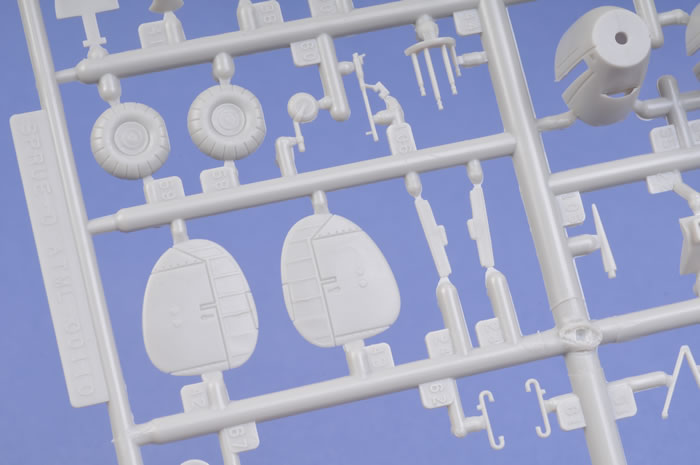
The exhausts are moulded in lengths of six onto a sturdy rectangular frame, making installation and alignment a simple matter.
The shapes of the sometimes tricky spinner and propeller blades look pretty good in this kit.
The radiator faces are separate parts that are fitted underneath the wings before the housings are glued into place. The faces should be visible from front and rear.
The DF loop is quite thick and will best be replaced with a couple of cirecles bent from copper wire.
The Airfix Bf 110 C.2/C-4 kit incudes a wealth of optional parts. Both the standard tail and longer boat tail extension are included, although only the short version is called out for this kit.
There is also a centreline ETC500 rack; two 500kg and two 250kg bombs; two 300 litre tanks complete with rather clever, one-piece mounts that should make assembly and alignment a breeze; two 900 litre tanks (with the same mounting system as the 300 litre tanks); and an auxiliary oil tank for the mid-fuselage.
Two crew figures are included, each with separate arms.
Parts breakdown is conventional, with locating pins and other devices that make this model perfectly appropriate for even less experienced modellers.
The canopy is supplied as a single part. It is quite thick but clear with crisply raised framing.
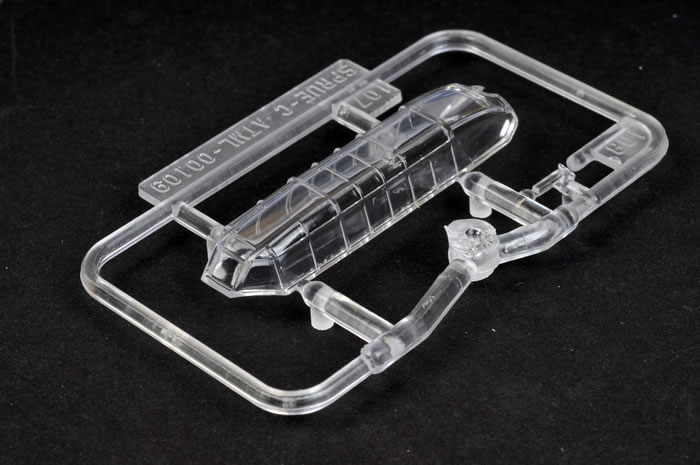
For those who would like to display their cockpit with an open canopy, I am sure that we will see aftermarket vacform canopies available soon.
The other clear part is the landing light for the wing leading edge. This has been thoughtfully moulded onto a long plug that will locate deep inside the wing - nice approach.
Markings
Two marking options are offered:
-
Messerschmitt Bf 110 C-2 - I/ZG 76, France 1940. This aircraft is finished in the eary-war colours of RLM 70 Black Green and RLM 71 Dark Green over RLM 65 Light Blue and features a striking shark's mouth.
-
Messerschmitt Bf 110 C-4/B - II/SKG 210, Russia 1941. This aircraft has the famous Wasp nose, and is finished in a winter whitewash over day camouflage. Most likely colours under the whitewash would be RLM 71 Dark Green and RLM 02 Grey.
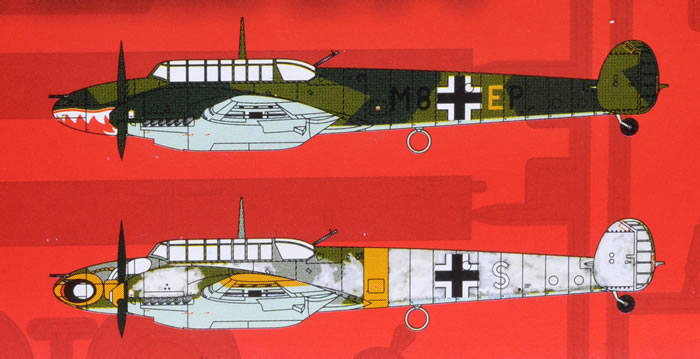
The decals are in register and show no sign of pixellation. I like the deep yellow interpretation of the RLM 04 colour.
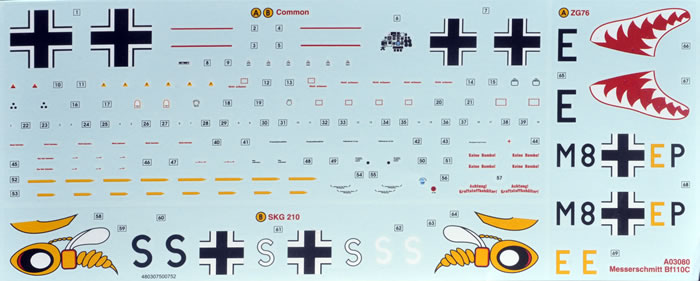
The decals are flat in finish.
Modellers have waited a very long time for a decent quality 1/72 scale Messerschmitt Bf 110 as a mainstream injection moulded kit. The new Airfix Bf 110 C-2/C-4 fills this important gap.
The budget price and straightforward parts breakdown will make this kit ideal for newer modellers too.
I do hope that Airfix will reconsider the nature of their surface detail though. I know that panel lines are a matter of taste, and perhaps unimportant to newer modellers, but I can't help thinking that Airfix would be snapping at the heels of Hasegawa if only panel lines were crisper and finer.
In my opinion this is a very good kit thanks to its overall accuracy, generally high level of detail and what looks to be ease of construction. It is certainly the best mainstream Messerschmitt Bf 110 in 1/72 scale.
Sample purchased by reviewer.
Text and Images Copyright © 2010 by Brett Green
Page Created 13 August, 2010
Last updated
14 August, 2010
Back to HyperScale Main Page |
